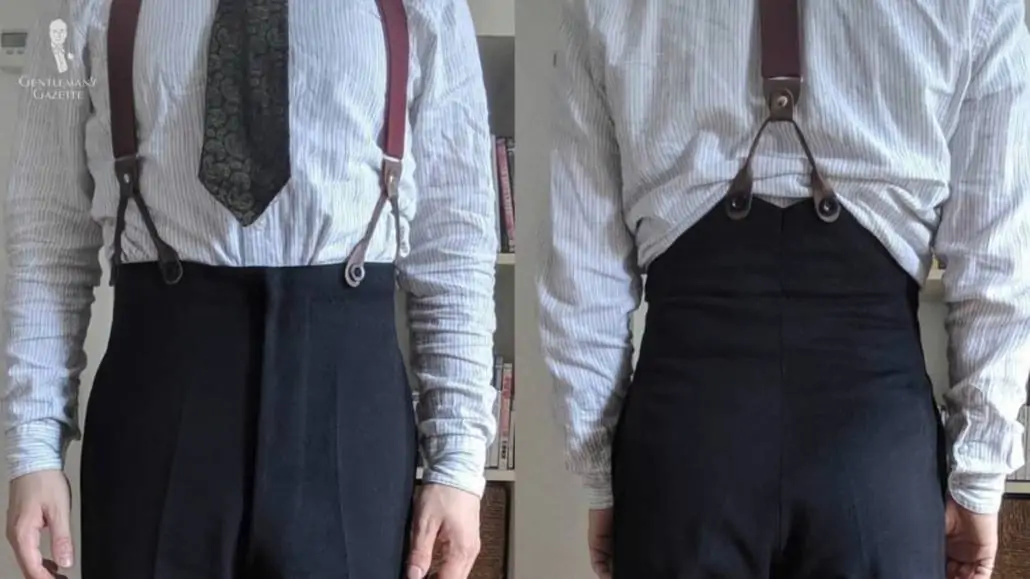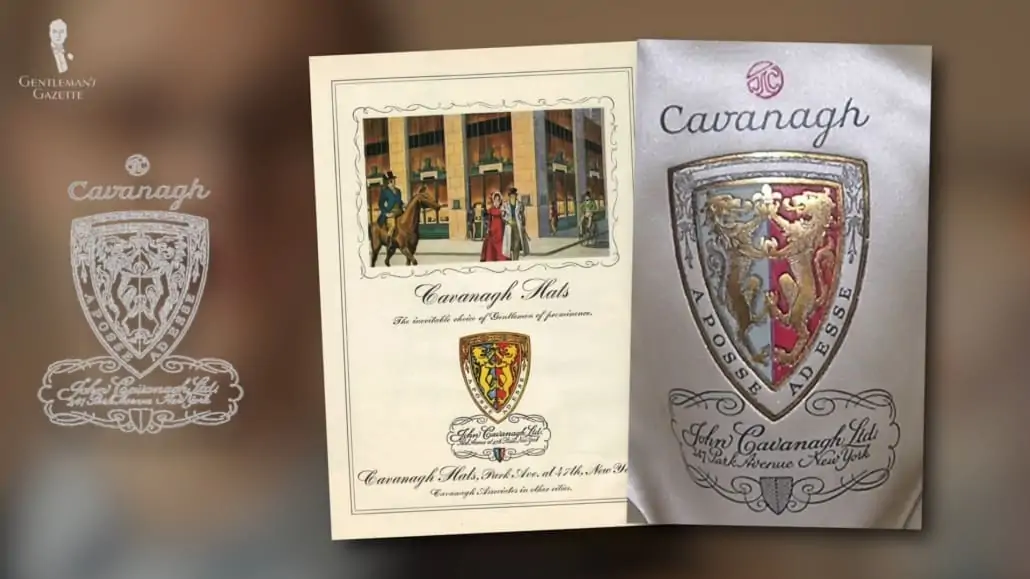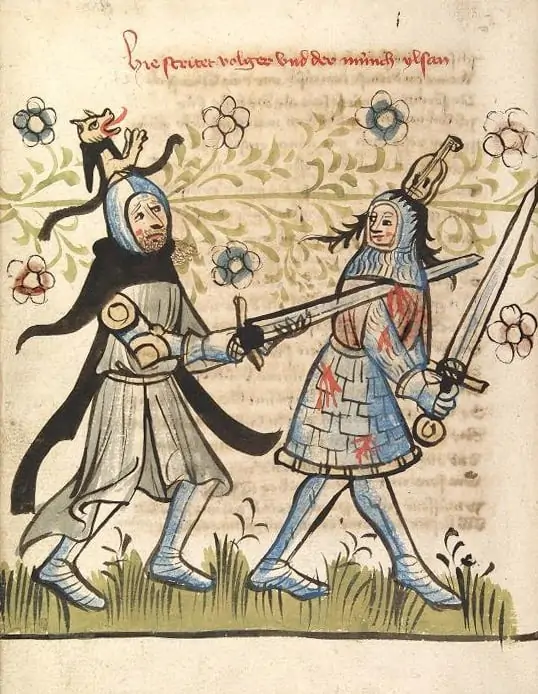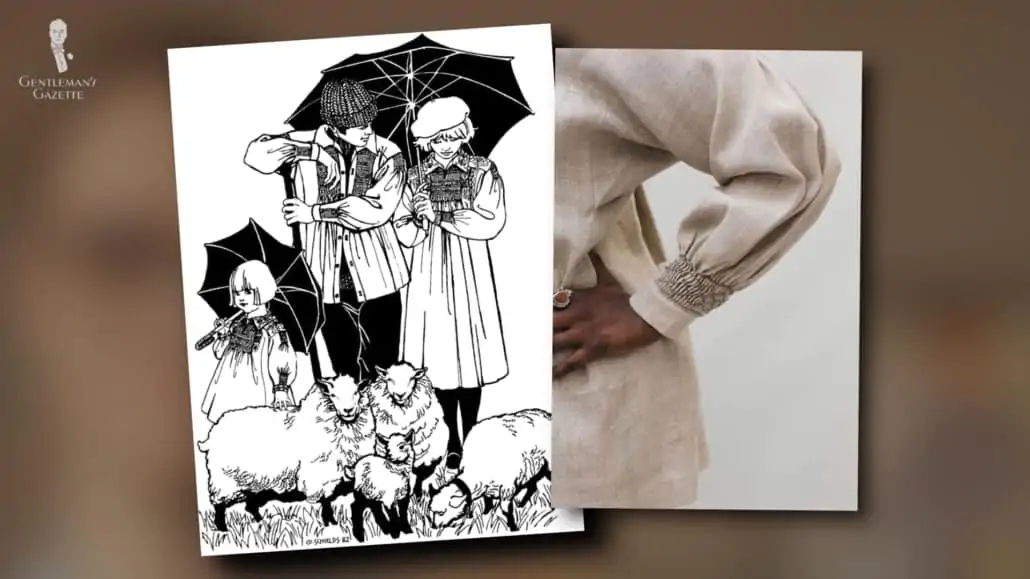Our frequent readers know that we’re big fans of history at the Gentleman’s Gazette. As our archive of content should prove, we consider ourselves experts on the Golden Age of Menswear, and know a good deal of other style terminology more broadly. But just how far does our knowledge extend? To answer this question, we put our Content Director, Preston Schlueter, to the test!
The following article contains in-depth summaries of all the terms covered in our challenge–but to see how well Preston scored on the quiz, be sure to watch the video above!
Obscure Menswear Terms: 1. French Bearer
Our first term today, the “French bearer,” refers to a piece of fabric sewn into a trouser’s waistband to keep the trousers straight. In the Victorian Era, the French bearer was somewhat reversed from what we would see later. This is to say, the fly would contain one or two extra buttons on the left, and a large tab that extended out of the side seam would be pulled around and buttoned on.

In America, however, these were often rendered as just a simple tab. The style evolved over time and is now most commonly seen as a tab extending from the fly with a buttonhole cut into it to receive a button located on the trouser waistband. And they can still be found on high-quality pairs of trousers today.
The idea behind the French bearer is that it will keep the trouser line straight at the waist, and it will also help you keep your trousers up while buttoning them. Because it also takes some of the stress off of the fly, it can make your trousers more hard-wearing.
It’s called a “French bearer” because the style was introduced in France and bore the burden of keeping the trousers up while they were being buttoned.
2. d’Orsay
Obscure menswear term number two: “d’Orsay” comes from the famous French dandy Alfred d’Orsay born in 1801. He was known to wear his top hats with fancy curled brims, and, thus, the style of a hat with a curled brim came to be named after him. Specifically, it refers to the tightly curled pencil roll you’ll find on some top hats, as well as others like Homburgs and bowlers.

3. Fishtail
Our third term today, “fishtail,” refers to the fact that when modern trousers were introduced in the 19th century. They had a v-shape in the rear of the waistband. This v-shape was essentially a remnant of the earlier breeches, which would be tied through lacing. Breeches would have a slit down the back, which a gusset would sometimes cover, but other times left open.
When trousers, which were essentially elongated breeches, became popular at the beginning of the 19th century, they too had this laced closing at the back. And when lacing died out in favor of cinch belts with buckles, the eyelets disappeared, but the slit remained. This left the v-shape at the rear of the trousers that allowed the wearer to pull in or let out the waistband.

In the 1930s, the waistbands of high-waisted trousers and their v-shaped backs reached quite a height and resembled fishtails, which is when we believe the term originated.
4. Cagoule
Next up is “cagoule,” which is a British word for a lightweight rain jacket. Although, this term might even be unfamiliar to most British people!
This jacket style is more commonly referred to in Britain as a “pac a mac,” which is the name the jackets were marketed under originally. We discovered this word through a rather amusing incident in our post on Mad Men.
The benefit of this lightweight jacket style is that it could be rolled up and placed or packed in a bag. The idea was first patented in the 1960s by the Peter Storm brand. But, it later shot to popularity once it was sold and marketed by the French brand K-Way in 1965 under the name “pac a mac.”
The name in long-form refers to packing a Macintosh, referring to the famous Macintosh-style coat first introduced in Scotland in 1824 and still produced today, though under Japanese ownership.
5. Retainer
You might think our number five term, “retainer,” has something to do with teeth. But, in fact, it doesn’t! In menswear, the term refers to a way to keep your necktie looking presentable.
Historically, when men would wear smooth, starched collars like standing collars or wing collars, there was the potential for the band of a necktie knot to slide around and look unsightly. Thus, retainers were used to stop the tie from sliding up the back of the collar.
They could be found in the form of either small loops of fabric at the back of a shirt, running vertically for a gentleman to thread his tie through, or in the form of pins, specially-shaped studs, or hooks.
Another form of the retainer was one that attached to the front collar stud and was designed to attach directly to the tie knot itself, and others were wires or small clips that were used to keep the knot looking good.
6. Union Suit
In the 19th century, men would wear under complicated and gaudy things with lacing at both the back and on the legs. And before this, men would simply tuck their shirts directly into their trousers, doing today what we would call “going commando.” It was clear that a better form of underwear was needed and, thus, the original “onesie,” the union suit, was introduced.

Specifically, the union suit is a one-piece style of long underwear covering the torso, arms, and legs that was worn from the 1860s up until the mid-20th century. They typically button up at the front and also have a drop seat, which is a flap at the rear. Curiously, these suits were originally created for women, but they eventually caught on for men as well.
And the name “union suit” comes from uniting the trouser portion and shirt portion together. In the UK, they were more commonly known as “combinations.” And, in case you’re interested, fear not because they are still available today.
7. Guyot
Next up is “guyot,” which comes from the name of the inventor, the Frenchman Charles Guyot.
Guyot was a French suspender maker, who began his business in 1848, and for the next 100 years, his company would continue to perfect their suspenders, patenting many types of adjuster buckles until their name became synonymous with quality. They’ve even boasted selling as many as two million suspenders annually.

Guyots are famous for their pull tab mechanism, which allows the wearer of suspenders to easily and simply adjust the suspender length without having to open a latch or fiddle with elastic. In other words, you can simply pull the tab on either side to adjust the length.
8. Cavanagh
We’ve got another name for our number 8 pick: “Cavanagh.” This one is Irish in origin and belongs to John Cavanagh, a major manufacturer of men’s hats for over 50 years. And he can boast some remarkable achievements.
While he began his career in 1880, by 1928 he had established his own brand, and in the 1930s he founded both the Hat Corporation of America and the Cavanagh Hat Research Corporation.

Specifically, within the world of hats, Cavanagh is often used to refer to the “Cavanagh edge,” a method of brim finishing, to which John Cavanagh gave his name in 1935. The Cavanagh edge is a felted edge created by welting the edge with a thin piece of yarn and then folding the edge back and over, and then stitching it in place.
The hat then goes through a further felting process that works the inner yarn and the outer hat fibers together. After which, the stitches are removed. The hats are then worked by hand in hot water to make the brim even.

This reinforced the hat’s brim, but the labor costs involved with this style of edge were so high that the brim would often cost as much as the hat itself. Thus, the Cavanagh edge isn’t a method you’re going to see employed on modern hats. For more information, our hat anatomy post has you covered.
9. Scye
No, our next term isn’t the name of a Star Wars alien, but rather, scye refers to the armhole in dressmaking and tailoring and is more commonly used in the form of the compound word “armscye.”

Scye is believed to come from the French word sier, which means “to cut.” The first time this word was recorded was in the 1825 etymological dictionary of the Scottish language by John Jameson. Some people believe that the word is a corruption of “arms’ eye,” but this is, in fact, uncorroborated.
Most technically, then, the term refers not to the hole itself but rather to the fabric edge onto which the sleeves of a garment are sewn.
10. Cockade
No, the cockade isn’t a sort of support for your nether regions. Rather, it, in fact, refers to a rosette, circular, or flower-shaped knot of ribbons used to associate oneself with a political faction, a particular rank, livery, or allegiance.

In the 18th century, these were commonly worn on bicorn or tricorn hats but could also be occasionally seen on the lapel of a jacket. In later years, they would be represented in all kinds of different materials, including metal, when seen on a helmet.

For example, cockades are still worn in some places to show political affiliation in the UK, and you might also see them in other applications, such as for 4-H Clubs in the United States.
11. Surcote
The next obscure menswear term is a bit of a stretch, and we’re going to have to go all the way back to the middle ages to see it used in its heyday. A surcote (or surcoat) is a garment originally seen in the 12th century that would go over the top of a suit of armor. It was generally long, reaching all the way down to the mid-calf, with slits that would allow a knight to ride a horse comfortably.
Some had sleeves, though many were sleeveless. It shouldn’t be confused with the shorter and always sleeveless tabard, which was more commonly worn and characterized by open sides.

As a way for knights to show their allegiance, the surcote would often be decorated with personal arms, heraldic symbols, allegiance, or iconography. In fact, this is where we get the phrase “coat-of-arms” as the coats were literally displaying the wearer’s arms.
Eventually, it made its way into civilian wear as an expensive top garment in the way of the sideless surcote and was worn by men and women alike. The fashion lasted until the 15th century when the later jupon phased it out.
12. Smocking
Our number 12 pick, “smocking,” refers to a garment-making technique consisting of gathering fabric and embroidering over it, which allows the fabric to stretch better.

It was commonly used for necklines and sleeves to allow the wearer to slip into the garment more easily. Unfortunately, not much is known about the origins of smocking, but it is a very old art form, dating again to the 12th century.
Shirts with large collars and heavy smocking were referred to as “smocks” and were commonly worn by working men in rural Britain, such as farmers and bakers, as utility and work garments to protect their underclothing.

Smocking died out in the Industrial Revolution as the garments were long and baggy and, therefore, could easily be caught or snagged in machines. It does continue to be used today, however, in clothing for women, both children and adults.
13. Collar Pleat
“Collar pleat” was a term used by SuitSupply as part of their in-store tailoring process which thoroughly stumped us when we heard it, but we may have an answer today as to what it means! Sometimes, when the shoulders of a jacket are more sloped than those of the wearer, a horizontal bulge can appear below the collar of a jacket that can be referred to as a “collar roll.”

This can easily be altered by a tailor, and given that SuitSupply is a company with a Dutch origin, it’s possible that the word “roll” was mistranslated as “pleat” here. This is perhaps because the word plooi in Dutch can mean both “bulge” and “pleat.” By the way, credit here goes to Dutch tailor Tom van het Hof for this revelation.

This could, therefore, mean that the measurement for the “collar pleat” actually refers to the correcting of the sloping of the shoulders and removing the collar roll, but this is ultimately just a guess on our part.
14. Onassis
Lastly, here, “Onassis” refers to both a Greek multi-millionaire and shipping magnate, and also to a tie knot. The knot itself is relatively simple, tied just like a standard four-in-hand, but at the end, rather than inserting the wide blade through the loop at the front, the blade is instead laid over the top and pulled tightly, creating the illusion of no knot at all.

For some fictional depictions, you can see it worn in Boardwalk Empire, particularly by the character of Gyp Rosetti, or by Johnny Depp’s character in Murder on the Orient Express.
Most often, the knot was secured with a pin or sometimes with tweezers behind the shirt. This can be a good way to show off the pattern of your favorite tie. But, it isn’t a knot that we would recommend wearing in formal settings.

While the knot is now named for Aristotle Onassis, it wasn’t originally his invention. In fact, you’re essentially tying the knot similarly to how one would tie an ascot. We simply refer to the knot by his name today because he was famously photographed wearing it in the 1960s.
Outfit Rundown
I’m wearing a simple and informal outfit of a subtly, multicolored cardigan sweater in blue and brown over a plain blue shirt. My trousers are also plain brown, though they do have a bit of a reddish undertone and my suede loafers are in a color called tobacco brown They’re from the company Scarosso.






For info, Cagoule is a very old French word (not British). It referred to the hooded gown worn by monks and priests. It came from the Latin ‘cuculla’. The Latin word passed into English as ‘cowl’ then cowling.
Thank you for the additional information! :)
No one says the word “cagoule” like Patsy in Ab Fab.
Illuminating and entertaining to learn of our sartorial history. Personally, I have encountered a gentleman in a posh London club who favours the “fishtail” on his bespoke suits.
TOO MUCH INFORMATION!!!
Thank you for your informative and entertaining videos. I especially appreciate your well spoken English, with very little “american accent”, to the benefit of us foreigners.
Keep up the good work!
Best Regards
Bengt H
Sweden
Dear Mr. Schlueter,
Well Done!
Please forgive the length of the rest of this missive in advance as I know the fashion is to post short witty comments or trite threadbare burst of piffle. The aforementioned forms of communication I only reserve for cocktail parties if I am particularly well pickled speaking to a complete bore whilst trying to extricate myself politely from the soul sucking ghoul.
I wholly support Mr. Schneider and your calling to bring a modicum of sartorial excellence in what has become a sea of callisthenic clothing and undergarment which the unwashed nee unshaven bandy about across the bits and bytes as if they have had an epiphany or they are disclosing arcane advice tantamount to interpreting the I Ching. Truly, it is not their fault as they are only aping the Pablum which they have been fed since birth from a low born culture which we now inhabit. This of course can only be blamed on their fathers and their father’s fathers embracing this lazy and slovenly ungentlemanly ethos which sprang from post World War II which then ultimately gave birth to the dimwitted folly of the late 1960’s on forward. This is the fulcrum from which all modern bad taste and base mannerisms has evolved. They tried to disguise their vain and ill informed proclivities for dressing like hobos and man-children as self expression. Sadly the gentleman of the day did not fight back hard enough from the tide of the dullards whom largely thought the only way to get a date on Saturday night was to dress like a buffoon. As you well know, It is from this era we get such abortions as Naugahyde, Dacron Polyester and other abrogation of real cloth including Nylon fabric which propelled them at the time into wearing such ridiculous things such as the leisure suit and bell bottom pants. (much to my horror when I was a younger).
We must all work hard to end this cycle and bring back gentlemanly good taste and manners. To this end I am doing my part to help combat this malaise. I have just made my first purchase of frippery from the Gentleman’s Gazette to ad to what can only be describe as a shrine to dandyism and foppery which I have curated nigh on 40 years wearing with relish and a bit of pride what springs forth daily from my overflowing closets. Now that I am advancing in age and the income that has undeservedly followed, I can tell you that the advice that you and Mr. Schneider give with regard to buying from a thrift shop or a bespoke garment is spot on. I started wearing what I called then “old man” clothing from a thrift shop when I was 12 years of age as what my family could afford to cloth me in and the choices available back in the 1970’s was as I previously intonated a cavalcade of polyester which was more suited for a side show act at the local carnival rather than what a gentleman or in my case a gentleman in training at the time would wear. I now have several bespoke suits, shoes, shirts and other item which I mix and match seamlessly with those thrift shop purchases using whatever seems appropriate for the occasion. As you and Mr. Schneider have pointed out several times; the price of the garment is not the mark of quality rather it is the fabric, fit and finish which truly matters.
Passing the mantle of good hygiene and having a well prepared suit with manners to match when you deport from your home is now the responsibility of the few of us left. The thought that checking if you had shined shoes and a clean handkerchief as mandatory before even thinking of dressing is now all but completely lost due to this ubiquitous reverse snobbery that we now inhabit. We all must do whatever we can to educate men of all ages on the proper dress and manners to display. Again, I would like to thank you and Mr. Schneider for your lovely web site and “le bon ton”
Kindest Regards,
Jimmy Keck
Great video Preston. I know that having your hair slicked down is appropriate when you are singing jazz, but in my opinion you look even better with it au naturale. I recommend that you wear it like that more often.